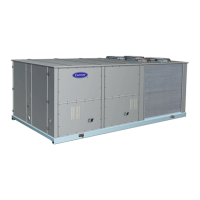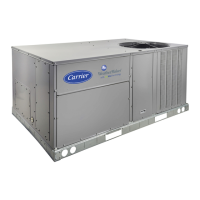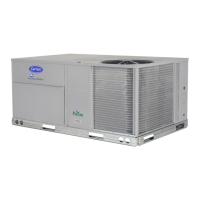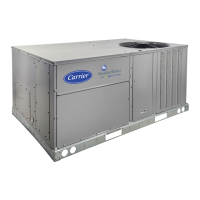79
RAT Low Alert Limit/Unocc (RA.L.U)
If the return-air temperature is below the configurable unoccu-
pied RAT Low Alert Limit (RA.L.U), then Alert 304 will be
generated. Unit operation will continue but VAV heating opera-
tion will be disabled. The alert will automatically reset.
RAT High Alert Limit/Unocc (RA.H.U)
If the return-air temperature is above the configurable unoccu-
pied RAT High Alert Limit (RA.H.U), then Alert 305 will be
generated. Operation will continue. The alert will automatical-
ly reset.
RARH Low Alert Limit (R.RH.L)
If the unit is configured to use a return air relative humidity
sensor (Configuration
UNIT
SENS
RRH.S), and the
measured level is below the configurable RH Low Alert Limit
(R.RH.L), then Alert 308 will occur. The unit will continue to
run and the alert will automatically reset.
RARH High Alert Limit (R.RH.H)
If the unit is configured to use a return air relative humidity
sensor (Configuration
UNIT
SENS
RRHS), and the
measured level is above the configurable RARH High Alert
Limit (R.RH.H), then Alert 309 will occur. The unit will con-
tinue to run and the alert will automatically reset.
Supply Duct Pressure Low Alert Limit (SP.L)
If the unit is a VAV unit with a supply duct pressure sensor and the
measured supply duct static pressure is below the configurable SP
Low Alert Limit (DP.L), then Alert 310 will occur. The unit will
continue to run and the alert will automatically reset.
Supply Duct Pressure High Alert Limit (SP.H)
If the unit is a VAV unit with a supply duct pressure sensor and
the measured supply duct static pressure is above the configu-
rable SP High Alert Limit (SP.H), then Alert 311 will occur.
The unit will continue to run and the alert will automatically
reset.
Building Pressure Low Alert Limit (BP.L)
If the unit is configured to use modulating power exhaust then
a building static pressure limit can be configured using the BP
Low Alert Limit (BP.L). If the measured pressure is below the
limit then Alert 312 will occur.
Building Pressure High Alert Limit (BP.H)
If the unit is configured to use modulating power exhaust then
a building static pressure limit can be configured using the BP
Hi Alert Limit (BP.H). If the measured pressure is above the
limit, then Alert 313 will occur.
Indoor Air Quality High Alert Limit (IAQ.H)
If the unit is configured to use a CO
2
sensor and the level is
above the configurable IAQ High Alert Limit (IAQ.H) then the
alert will occur. The unit will continue to run and the alert will
automatically reset.
Sensor Trim Configuration
The TRIM submenu is used to calibrate the sensor trim set-
tings. The trim settings are used when the actual measured
reading does not match the sensor output. The sensor can be
adjusted to match the actual measured reading with the trim
function. A list is shown in Table 72.
Air Temperature Leaving Supply Fan Sensor (SAT.T)
This variable is used to adjust the supply fan temperature sen-
sor reading. The sensor reading can be adjusted ± 10°F to
match the actual measured temperature.
Return Air Temperature Sensor Trim (RAT.T)
This variable is used to adjust the return air temperature sensor
reading. The sensor reading can be adjusted ± 10°F to match
the actual measured temperature.
Outdoor Air Temperature Sensor Trim (OAT.T)
This variable is used to adjust the outdoor air temperature sen-
sor reading. The sensor reading can be adjusted ± 10°F to
match the actual measured temperature.
Space Temperature Sensor Trim (SPT.T)
This variable is used to adjust the space temperature sensor
reading. The sensor reading can be adjusted ± 10°F to match
the actual measured temperature.
Suction Pressure Circuit A Trim (SP.A.T)
This variable is used to adjust the suction pressure sensor read-
ing for circuit A. The sensor reading can be adjusted ± 50 psig
to match the actual measured pressure.
Suction Pressure Circuit B Trim (SP.B.T)
This variable is used to adjust the suction pressure sensor read-
ing for circuit B. The sensor reading can be adjusted ± 50 psig
to match the actual measured pressure.
Discharge Pressure Circuit A Trim (DP.A.T)
This variable is used to adjust the discharge pressure sensor
reading for circuit A. The sensor reading can be adjusted ±
50 psig to match the actual measured pressure.
Discharge Pressure Circuit B Trim (DP.B.T)
This variable is used to adjust the discharge pressure sensor
reading for circuit B. The sensor reading can be adjusted ±
50 psig to match the actual measured pressure.
4 to 20 mA Inputs
There are a number of 4 to 20 mA inputs which may be cali-
brated. These inputs are located in Inputs
4-20. They are:
• SP.M.T — static pressure milliamp trim
• BP.M.T — building pressure milliamp trim
• OA.M.T — outside air cfm milliamp trim
• RA.M.T — return air cfm milliamp trim
• SA.M.T — supply air cfm milliamp trim
Discrete Switch Logic Configuration
The SW.LG submenu is used to configure the normally open/nor-
mally closed settings of switches and inputs. This is used when
field-supplied switches or input devices are used instead of Carrier
devices. The normally open or normally closed setting may be dif-
ferent on a field-supplied device. These points are used to match
the control logic to the field-supplied device.
The defaults for this switch logic section will not normally need
changing. However, if a field-installed switch is used that is differ-
ent from the Carrier switch, these settings may need adjustment.
Settings for switch logic are found at the local displays under
the Configuration
SW.LG submenu. See Table 73.
Filter Status Input — Clean (FTS.L)
The filter status input for clean filters is set for normally open.
If a field-supplied filter status switch is used that is normally
closed for a clean filter, change this variable to closed.
IGC Feedback — Off (IGC.L)
The input for IGC feedback is set for normally open for off. If a
field-supplied IGC feedback switch is used that is normally
closed for feedback off, change this variable to closed.
IMPORTANT: Sensor trim must not be used to extend
unit operation past the allowable operating range.
Doing so may void the warranty.
IMPORTANT: Many of the switch inputs to the con-
trol can be configured to operate as normally open or
normally closed.

